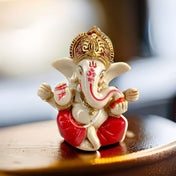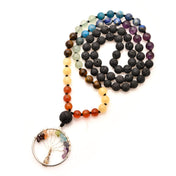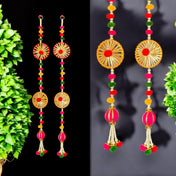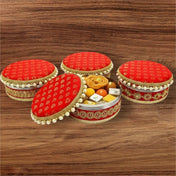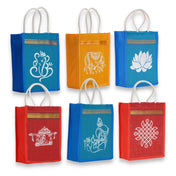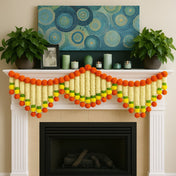Introduction
Navratri is a lively festival celebrated with enthusiasm and passion, and it holds great importance in the United States as a time to honor the divine feminine energy. As devotees get ready for the Nine Nights of Devotion, it's crucial to explore the details of the Navratri Pooja Items Checklist. This checklist serves as a guide, ensuring that every ritual is performed with care and devotion.
Proper preparation is key during these auspicious days, and LoveNspire is here to help you find beautiful decorations, pooja items, and meaningful gifts to make your Navratri celebrations even more special. Whether you're looking for traditional decorations or one-of-a-kind offerings, LoveNspire has a wide selection of products that capture the spirit of this festival.
One of the important things on your Navratri checklist is to have lovely decorations that create a holy atmosphere for worship. For example, our Happy Navratri banner and traditional backdrop cloth can greatly enhance your pooja setup.
Additionally, Garba nights are an important part of the Nine Nights of Devotion. To make these nights unforgettable, consider our Garba Night banner, which is perfect for both indoor and outdoor decorations.
In this article, we will explore the significance of Navratri through the lens of preparation and devotion. Each item on the checklist plays a crucial role in creating a sacred atmosphere for worship.
Understanding the Importance of Navratri Pooja Items Checklist
The Navratri Pooja items checklist is an important tool for devotees to perform their worship ceremonies with love and devotion. It helps them remember all the things they need for the rituals and ensures that nothing is missed.
Significance of Each Item in Worship
Every item on the checklist has a special meaning and purpose in honoring Goddess Durga during Navratri. These items are carefully chosen to create a sacred space for worship and invite divine blessings into the home.
Creating a Spiritual Atmosphere
The Navratri Pooja items checklist also plays a role in creating an environment that is conducive to spiritual connection. Each item contributes to setting up a peaceful and uplifting atmosphere where one can pray, meditate, and connect with the divine.
Invoking Positive Energy
By following the checklist and using the specified Pooja items, devotees believe that they can attract positive energies and blessings from Goddess Durga. The act of preparing for the rituals with intention and mindfulness is seen as a way to invite her grace into their lives.
Understanding the significance of the Navratri Pooja items checklist allows individuals to deepen their engagement with the festival's spiritual practices. It encourages them to approach each ritual with reverence, knowing that every detail matters in creating an authentic worship experience.
1. Kalash Sthapana Essentials
Kalash Sthapana Significance
- Kalash: The sacred vessel symbolizing Goddess Durga's presence during Navratri.
- Coconut: Represents the divine consciousness and purity to offer prayers.
- Mango Leaves: Symbolize prosperity and fertility in the household.
- Turmeric: Known for its purifying properties and used to adorn the Kalash.

Tradition Maintenance with Akshat and Nav Dhanya Seeds
- Akshat signifies unbrokenness and prosperity, showered during rituals for blessings.
- Nav Dhanya seeds represent the nine forms of Goddess Durga and are vital for invoking her energy.
By understanding the significance of each item in the Kalash Sthapana ritual, devotees can connect deeply with the spiritual essence of Navratri. These elements not only enhance the ambiance but also serve as conduits for positive vibrations and divine blessings throughout the nine nights of devotion.
2. Items for Worship and Decoration
When preparing for Navratri Pooja, the selection of worship items and decorations is extremely important. They create an atmosphere that reflects both respect and celebration. Let's explore the key components that can enhance your Navratri festivities:
1. Importance of Worship Items
The worship items used during puja hold great significance in establishing a sacred environment. Here are two essential elements to consider:
- The idol or photo of Goddess Durga: This central figure represents strength, protection, and divine grace.
- The Chowki: A platform for the deity, symbolizing stability and respect within the ritual space.
2. Significance of Solah Shringar Items
Solah Shringar items play a vital role in adorning the goddess throughout Navratri. These adornments embody beauty, elegance, and devotion. Each piece, from the bindi to the anklets, carries its own symbolic meaning that deepens the spiritual connection with Goddess Durga.
3. Festive Ambiance with Decorative Elements
To uplift the festive atmosphere during Navratri, decorative elements such as flowers, rangoli designs, and vibrant embellishments are key. Flowers symbolize purity, positivity, and offerings to deities while rangoli designs add color and artistic expression to your surroundings.
By thoughtfully choosing and arranging these worship items and decorations, you not only create an visually appealing setting but also invite sacred energies into your space. Embrace each element with reverence and intention to fully immerse yourself in the spiritual essence of Navratri.
3. Ritual Materials for Navratri Pooja
The sacred atmosphere of Navratri Pooja is greatly enhanced by ritual materials that uplift devotion and invite the presence of the divine. These elements not only serve practical purposes but also carry spiritual symbolism, creating a rich tapestry of faith and reverence.
Akhand Jyoti Setup
An essential component of the Navratri Pooja is the Akhand Jyoti—an eternal flame that burns continuously throughout the nine nights. This lamp symbolizes purity, enlightenment, and the constant presence of Goddess Durga’s energy.

- Traditionally, the Akhand Jyoti is lit using ghee or oil in a brass or earthen lamp.
- Its uninterrupted flame represents the removal of darkness from life and the victory of good over evil.
- Positioned near the deity, this lamp serves as a calming focal point during rituals.
- Complementing the Akhand Jyoti are incense sticks (Agarbatti), whose fragrant smoke purifies the surroundings, enhances focus, and invites auspicious vibrations.
- The gentle flicker of incense smoke also signifies prayers rising to the divine realm.
Naivedya Offerings
Offering Naivedya during Navratri is a way to express love and surrender to the goddess, acknowledging her blessings through tangible offerings.
- Naivedya typically includes a variety of fresh fruits, sweets like ladoos and kheer, cooked grains such as rice or wheat preparations, and seasonal delicacies.
- Each item holds symbolic meaning: fruits represent nature’s abundance; sweets signify joy and prosperity; grains denote sustenance and fertility.
- The act of offering food cultivates gratitude and fosters a sacred connection between devotee and deity.
- After the puja, these offerings are distributed as Prasad, believed to carry divine blessings that nourish both body and soul.
Sacred Threads (Kalava)
The use of Kalava, a sacred red-yellow thread tied around wrists or on puja elements, is an integral part of Navratri rituals.
- Kalava threads are infused with mantras and sanctified by priests before being used.
- Wearing this thread invokes protection from negative energies and symbolizes commitment to spiritual practices during the festival.
- In some traditions, Kalava is tied on the Kalash or altar as a mark of sanctity.
- The colors themselves hold deep significance—red stands for power and purity while yellow embodies auspiciousness and sanctity.
These ritual materials—Akhand Jyoti setup, Naivedya offerings, and sacred threads—not only meet traditional requirements but also deepen emotional engagement with Navratri’s spiritual essence. Their presence in your puja space invites positive energy, blessings, and a profound sense of connection with Goddess Durga’s divine grace.
4. Additional Preparations for Navratri Pooja
During Navratri, there are a few more preparations you can make to enhance the spiritual atmosphere and create a welcoming environment for the festivities. Here are some important aspects to consider:
1. Importance of Puja Area Decoration
Cleanliness and aesthetic decoration play a vital role in setting the sacred ambiance during Navratri. Adorn your puja area with vibrant flowers, colorful rangoli designs, and traditional decorations to enhance the spiritual atmosphere.
2. Tilak Application
Before starting the puja rituals, it is customary to apply tilak on the deity's image or idol as a sign of respect and devotion. This act symbolizes offering reverence and seeking blessings from the divine during Navratri.
3. Welcome Rituals
A significant tradition during Navratri is welcoming Goddess Durga into your home with rituals that show hospitality and respect. Hang a toran or bandhanwar made from mango leaves at the entrance as a customary practice to invite good fortune and blessings into your household.
By focusing on cleanliness, decorative elements, tilak application, and welcoming rituals, you can create a spiritually uplifting environment for Navratri Pooja. These practices not only honor traditions but also foster a sense of devotion and connection with the divine energies invoked during this auspicious festival.
LoveNspire: Your One-Stop Shop for Navratri Decorations, Pooja Items, and Gifts!
LoveNspire is the perfect place for anyone who wants to celebrate Navratri in a genuine and stylish way. They have a wide range of carefully chosen products that perfectly match the Navratri Pooja Items Checklist: Essential for Your Nine Nights of Devotion, making it easy and inspiring to get ready for the festivities.
What LoveNspire Offers for Navratri
1. Decorations
LoveNspire offers a variety of decorations that combine tradition with a fresh perspective. From elegant torans made with mango leaves to vibrant rangoli stencils and floral arrangements, these elements not only beautify your pooja space but also invite auspicious energies, creating an atmosphere conducive to divine worship.
2. Pooja Essentials
When it comes to puja essentials, LoveNspire has you covered with a range of items sourced with great care. Kalash sets, idols of Goddess Durga, incense holders, Akhand Jyoti lamps, and sacred threads are just some of the offerings available. Each piece reflects a blend of traditional artistry and modern aesthetics, ensuring that your rituals are both authentic and visually pleasing.
3. Gift Selections
Handpicked gifts celebrate relationships and devotion alike. Personalized items, ethnic jewelry, and home décor pieces serve as thoughtful tokens that resonate with the spirit of Navratri — nurturing bonds through meaningful exchanges. For instance, personalized Diwali gift hampers or decorative gift boxes filled with sweets and dry fruits can serve as perfect gifts during this festive season.
Crafted by artisans passionate about preserving Indian heritage, LoveNspire’s offerings transform everyday celebrations into memorable spiritual experiences. This dedication ensures every item supports your ritual practice while enhancing the overall ambiance of your Navratri festivities.
Conclusion
Celebrate Navratri with devotion using the essential pooja items from LoveNspire's collection.
- Immerse yourself in the spiritual ambiance of Navratri by incorporating these significant items into your rituals.
- Elevate your worship experience with authentic and high-quality products that honor tradition and craftsmanship.
Explore LoveNspire's website for their exclusive range of products curated specifically for this festival.
- Discover a treasure trove of Navratri decorations, pooja essentials, and unique gifts that resonate with cultural richness and authenticity.
- Let LoveNspire be your guide in creating memorable and meaningful moments during the nine nights of devotion.










